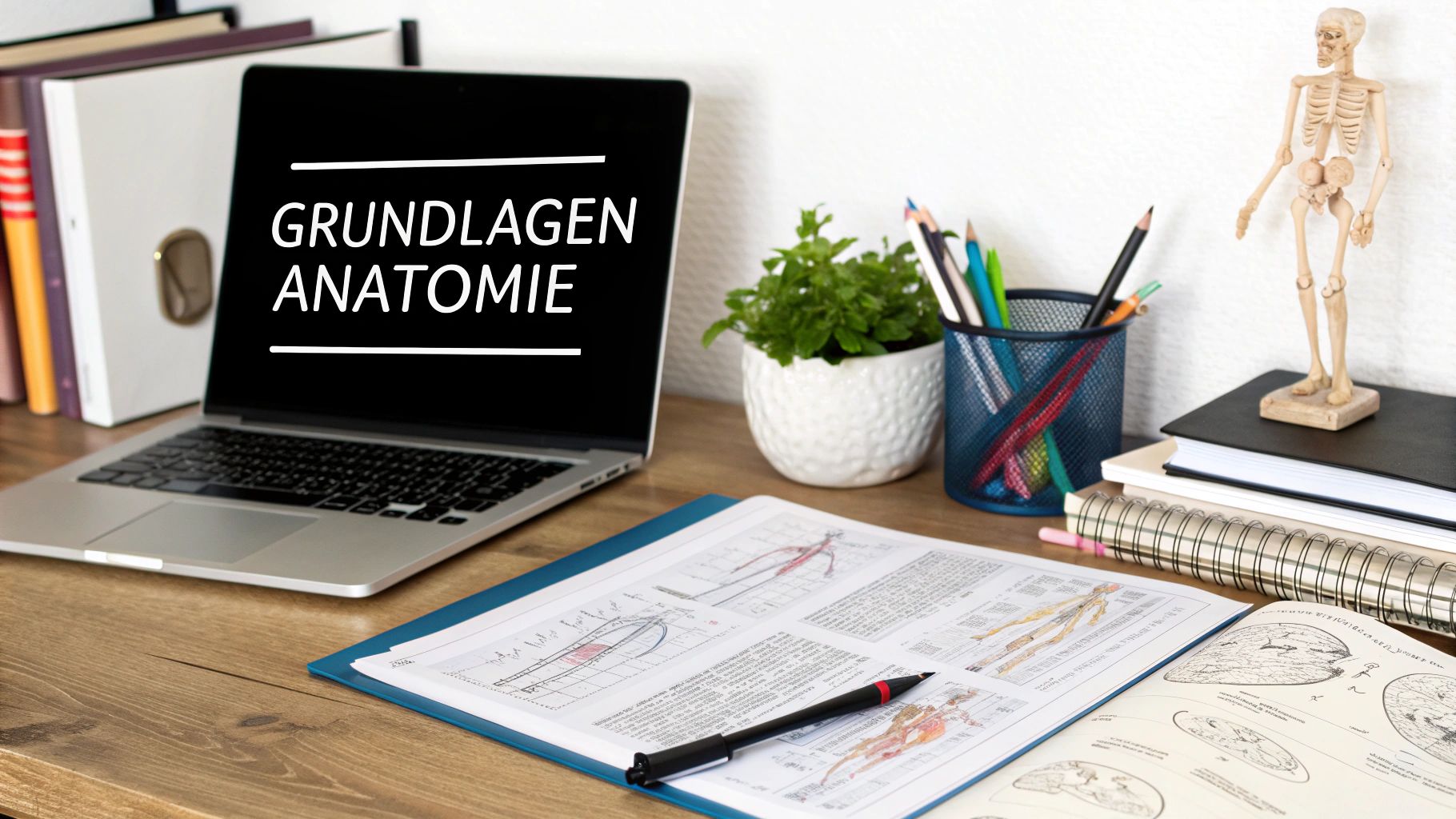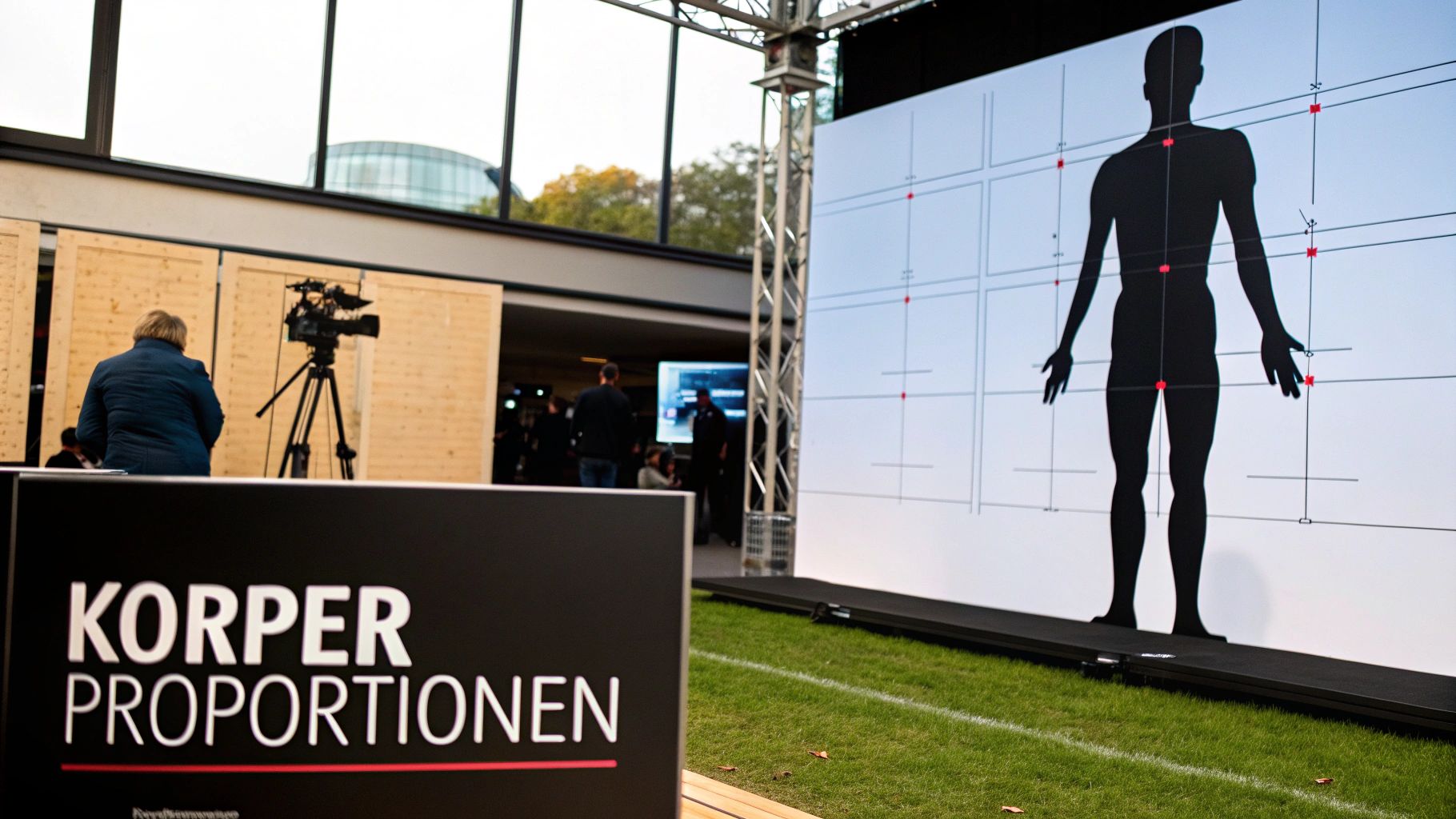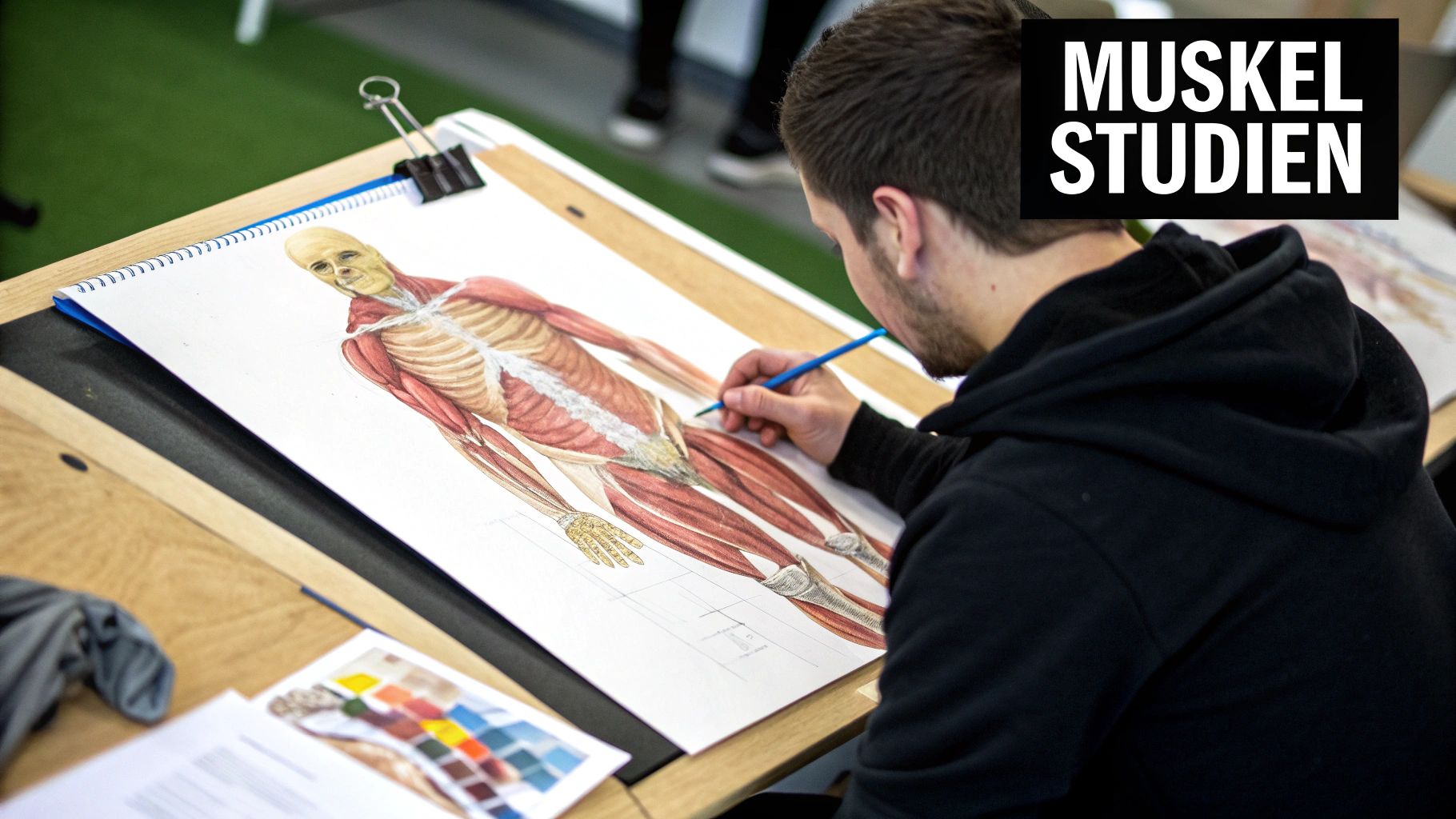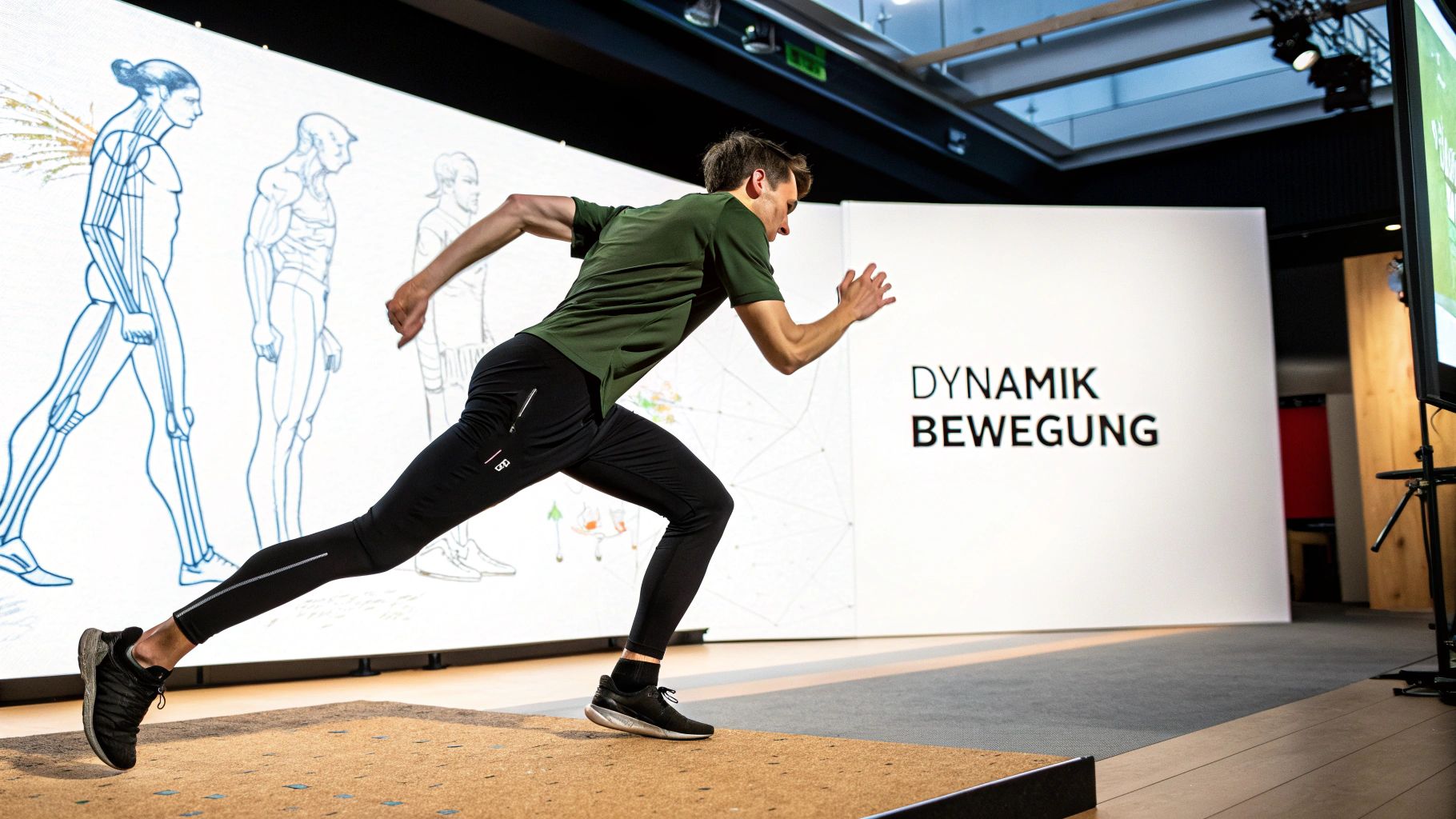The Masters of Anatomy and their Lasting Legacy

Anatomical study is far more than just the depiction of muscles and bones. It is a fascinating journey through art history. Artists like Leonardo da Vinci and Albrecht Dürer were true pioneers who opened up anatomical drawing for art and thus revolutionized the realistic representation of the human body.
Their thirst for knowledge and the pursuit of anatomical accuracy laid the foundation for generations of artists.
Leonardo da Vinci's Look Inside
Da Vinci's anatomical studies went far beyond the purely artistic. He dissected corpses to understand the complex structures of the body. His detailed drawings of muscles, tendons, and organs are not only artistically impressive but also scientifically remarkable.
This unique combination of art and science allowed him to depict the human body with previously unknown precision.
Dürer's influence on the art of anatomy
Albrecht Dürer also dedicated himself intensively to anatomy. He recognized the importance of anatomical knowledge for artistic representation and developed methods for the precise reproduction of proportions and perspective.
His studies had a lasting influence on the art of his time and are still relevant today.
Anatomical drawing has a long tradition, particularly in German art academies. In Dresden, for example, Artistic Anatomy has been taught since 1764 . Artists and physicians taught there together.
This academic engagement with human anatomy was of great importance for both artists and physicians. Until the 20th In the 18th and 19th centuries , anatomical drawing was part of the basic training in many European art academies. Today, students in Dresden use the anatomical collection of theDresden Academy of Fine Arts to develop a deep understanding of the body's form and function.
Learn more about the history of anatomical drawing in Germany here:History of Anatomical Drawing .
The Legacy of the Masters
The insights of these masters are still relevant for aspiring artists today. Their works demonstrate the importance of understanding the human body for convincing representations.
Studying their works makes it possible to benefit from the experience of these pioneers and improve one's own skills in anatomical drawing. It's not just about correctly reproducing anatomy, but also about the ability to express this knowledge artistically.
The combination of anatomical precision and artistic vision is the true legacy of the masters.
Anatomical foundations that will improve your drawings

Forget complicated anatomy books! Here you will receive the knowledge that directly enhances your drawings. We focus on the most important anatomical structures that give the body its shape, and show you how to convincingly bring these to paper.
From skeleton to silhouette: The basis for realistic figures
The foundation of every good anatomical drawing is theskeleton . It is the framework that determines the proportions and posture of the body. You can think of it as a scaffold that dictates the outer form.
Building on this, the muscles shape the silhouette. They are responsible for the dynamic forms and movements. Understanding how muscles attach and change in different poses will make your drawings more lifelike.
Visible Muscles and Anatomical Simplification
Not every muscle is clearly visible under the skin. Through discussions with professional anatomy artists, we have learned which muscle groups can be emphasized and which can be simplified. This saves time and helps to focus on the essential details. This way, you avoid overloaded drawings and achieve a clearer representation.
Additionally, figure drawing plays an important role in learning anatomy in Germany. It is often offered in art schools and adult education centers to study proportions and anatomy. At art academies, it is even part of the basic training.Learn more about figure drawing .
To illustrate the most important proportions, the following table serves as a helpful overview:
Important Body Proportions at a Glance
This table shows the classical proportions of the human body, which serve as a guide for anatomical drawing.
| Body Part | Ratio to Body Height | Specifics |
|---|---|---|
| Head | 1/7 - 1/8 | Varies depending on age and stylization |
| Torso (Head to Crotch) | approx. 3 heads | |
| Legs (Crotch to Foot) | approx. 4 heads | |
| Arms (Shoulder to Fingertip) | approx. 3 Heads | |
| Hands | approx. head width | |
| Feet | approx. head length |
The table illustrates the basic proportions that serve as a starting point for realistic drawings. Individual deviations are of course possible and contribute to the characterization of the figures.
The subtle difference: Anatomical accuracy vs. visual impact
Anatomical accuracy is important, but not the only factor. Sometimes anatomical details have to be adjusted in favor of the visual impact. Small details can make the difference between an amateur and a professional drawing. The emphasis of certain muscle groups, for example, can enhance the dynamism of a pose, even if it is not one hundred percent anatomically correct.
You might be interested in: How to master...
Practical application for immediate results
Our goal is to provide you with practical knowledge that you can apply immediately. You should not only understand the anatomical concepts but also implement them in your drawings. Therefore, we emphasize practical examples and exercises. This way you internalize what you have learned faster and achieve visible progress.
From the inside out: The key to figure drawing

Convincing figure drawings begin with an understanding of anatomy from the inside out. The first step is to grasp the skeletal structure . It forms the foundation, the framework for the proportions and posture of the body. Imagine an inner framework that determines the outer form.
Building upon this, musculature and tissue can be developed. This approach helps you draw anatomy and depict the human body authentically.
The Skeleton: Your Foundation for Anatomical Drawing
The skeleton is essential for understanding the human form. It defines the basic proportions and the possibilities of movement. Mastering the skeleton allows you to create believable poses and avoid anatomically impossible depictions.
Focus initially on the most important bones and joints. Details can be added later.
Muscles and Movement: Anatomy in Action
Muscles dynamically shape the body. They cover the skeleton and influence the body's form during movement. It is important to understand how muscles attach and interact. This allows body tension and movement to be depicted realistically.
Practice drawing muscles in various positions to develop a sense of how they function. In Germany, there is a high demand for anatomy learning materials.
Books like the "Anatomical Drawing School" offer comprehensive instructions and examples. They support artists in learning linework, perspective, and shading in the context of anatomy.Learn more about learning to draw anatomy .
Avoid case studies and common mistakes
Practical examples simplify complex anatomical relationships. You will learn to recognize and correct common proportional errors. A typical mistake is the exaggerated representation of muscles.
Targeted exercises and reference material help to avoid such mistakes and improve your drawings.
Creating Authentic Body Tension
Realistic body tension brings drawings to life. Understanding the relationship between skeleton, muscles, and posture is crucial for this. Pay attention to how muscles tense and relax.
These details make the difference between a stiff and a dynamic figure. Practice and observation promote the feeling for the subtle representation of body tension.
Tried and tested exercises that really work

Frustrating exercises with no visible results are a thing of the past. This section offers a collection of exercises used by professional artists and guaranteed to lead to measurable improvements. Whether 5 minutes for a quick warm-up or several hours for an intensive training session – here you'll find the right challenge for your level and your time budget.
Effective Practice without a Model
Do you absolutely need a model to draw anatomy? Not necessarily! There are effective methods to make progress even without constant access to a model. Reference materials such as anatomy books, photos, and sculptures are valuable tools.
The key lies in using reference material strategically, without simply copying it. Focus on understanding the underlying anatomy and interpreting the forms.
Measuring Progress and Overcoming Difficulties
How can you objectively assess your own progress? By regularly comparing your drawings and obtaining feedback. Photograph your drawings to document your development.
Exchanging ideas with other artists can open up new perspectives and help identify weaknesses. Hands, feet, and dynamic poses present challenges for many artists. Specific exercises can provide targeted remedies.
For example, by repeatedly sketching hands in different positions, you develop a feeling for the complex anatomical structures.
To get the most out of the following exercises, we have compiled a table to help you find the right exercise for your skill level.
The table "Anatomy Exercises for Different Skill Levels" offers structured exercises for beginners, advanced learners, and professionals in anatomical drawing.
| Difficulty | Exercise | Focus | Time Required | Materials Needed |
|---|---|---|---|---|
| Beginner | Draw a skeleton | Bone structure and proportions | 15-30 minutes | Anatomy book, pencil, paper |
| Advanced | Draw muscles over the skeleton | Interaction of bones and muscles | 30-60 minutes | Anatomy book, pencil, paper |
| Professional | Draw a dynamic pose from imagination | Anatomical understanding and movement sequences | 1-2 hours | Pencil, paper |
The table shows that the time required and the materials needed increase with increasing difficulty. While beginners focus on the fundamentals of bone structure, professionals engage with complex movement sequences from imagination.
Motivation and Continuous Improvement
Learning to draw anatomy is a process that requires time and patience. Set realistic goals and celebrate your successes. Experiment with different techniques and find out what works best for you.
Focus on continuous, motivating improvement instead of perfection. Explore our anatomical products to support your learning process.
Through regular practice and targeted training, you will continuously improve your anatomy drawing skills and achieve your artistic goals.
Recognizing and Overcoming Anatomical Pitfalls
When drawing the human anatomy, even for experienced artists, recurring challenges emerge. This section highlights seven common mistakes and provides guidance on how to correct them. Before-and-after examples illustrate the impact of small changes . You will learn to identify typical stumbling blocks such as overdrawn muscles, unrealistic joints, and anatomically impossible poses early on. Practical checklists support you in the critical evaluation of your own work. And most importantly: You will learn how to accept and constructively implement feedback from others without losing your artistic vision.
The 7 Most Common Mistakes in Anatomy Drawing
Exaggerated Musculature: Musculature is often portrayed too prominently, making the figures appear unrealistic. Focus on the essential muscle groups and ensure smooth transitions.
Incorrect Proportions: The proportions of the human body are fundamental to a credible representation. Guidelines and measuring methods will help you find the correct ratios.
Stiff Joints: Joints are complex structures that enable movement. Consider how joints behave in different positions to avoid stiff depictions.
Unnatural Poses: Some poses are simply not anatomically feasible. Check the range of motion of the joints and the corresponding muscle tension.
Ignoring Skeletal Structure: The bones form the basic framework of the body. An understanding of skeletal structure allows for more realistic poses and proportions.
Lack of Body Tension: Body tension gives the figure dynamism and liveliness. Pay attention to how muscles tense and relax in different poses.
Incorrect Perspective: Perspective influences the representation of the body. Consider how proportions and shapes change with perspective.
Correction Methods and Checklists for Your Drawings
To avoid the mentioned errors, here are some practical tips:
Use Reference Images: High-quality anatomy atlases and photos are valuable tools.
Practice Regularly: Only through practice will you improve your skills. Sketch daily, even if it's only for a short time.
Get Feedback: Show your drawings to other artists and get feedback.
Use Checklists: Create checklists for the most important anatomical features. This allows you to systematically review your work. Examples: Are the proportions of the head correct? Are the joints depicted as movable? Does the pose appear natural?
Accepting Constructive Feedback and Maintaining Artistic Vision
Feedback can be helpful, but it's important to use it constructively. Not all criticism is justified. The goal is to improve your skills without abandoning your artistic vision. Be open to suggestions, but stay true to your style.
By combining anatomical knowledge, regular practice, and the ability to process feedback constructively, you will reach a new level in anatomical drawing. Mastering anatomy is an important step for expressive and convincing figure representations.
Digital tools that accelerate your anatomy knowledge
Digital tools today offer unprecedented opportunities to explore anatomy in detail and deepen understanding of the human body. From interactive learning apps to complex 3D models, there are a wealth of resources that can significantly facilitate learning anatomy, especially for drawing.
3D Anatomy Models: Experience anatomy up close
With 3D anatomy models , the human body can be virtually explored and dissected. Individual muscles, bones, and organs can be isolated and viewed in relation to each other. This promotes the understanding of spatial relationships. Some programs even allow the simulation of movements, which vividly illustrates body dynamics.
Learning Apps: Anatomy on the Go
Learning apps enable flexible learning, wherever you are. Integratedquizzes , exercises and interactive diagrams help to test and consolidate knowledge. Many apps also work offline, so you can learn anytime, anywhere. When choosing an app, make sure to use German-language apps or those with a German translation.
AI-powered Learning Platforms: Personalized Anatomy Learning
AI-powered learning platforms offer personalized learning by analyzing learning progress and adapting exercises to individual needs. This allows weaknesses to be specifically identified and improved through appropriate exercises. Some platforms also offer personalized feedback and helpful learning tips.
Free vs. Paid Resources: Which is Right for You?
Both free and paid digital resources are available for anatomical drawing. Free apps and websites often offer a good introduction to the basics of anatomy. For more intensive study with specialized features, paid programs are usually more suitable. Trial versions or free trial periods allow you to compare different offers before deciding on a specific program.
Testimonials and Combining Traditional and Digital
Many artists combine traditional drawing methods with digital tools. Testimonials from artists who use both worlds offer inspiration and valuable tips. This allows you to combine the best of both approaches to optimize anatomical understanding and drawing skills. Further information and inspiration can be found in our guide on further pages.
Digitization vastly expands the possibilities of anatomical drawing. By combining traditional techniques and digital tools, you can gain a deeper understanding of human anatomy and fully develop your artistic skills.
From Anatomical Precision to Artistic Style
Learning to draw anatomy – at first, it sounds like the precise reproduction of muscles, bones, and tendons. But what happens when you master these fundamentals? That's precisely when the door opens to an exciting path: the transformation of anatomical precision into your own, unique artistic style.
Anatomical Knowledge: A Tool for Individual Expression
Successful artists demonstrate that anatomical knowledge is not a rigid corset, but a tool for creative expression. It forms the foundation upon which they build their individual style. Sometimes they adhere strictly to anatomical guidelines to achieve Hyperrealism . Then again, they consciously break these rules to achieve a very specific expression.
Style Development: From Realistic to Abstract
Between exact representation and stylized interpretation, a wide spectrum of possibilities exists. In Comics or Manga , for example, anatomy is often simplified and exaggerated to emphasize certain character traits. Expressionist painting also distorts anatomy to enhance the emotional impact.
Finding Your Balance: Precision and Freedom
How do you find your personal balance between anatomical accuracy and artistic freedom? Simply: Experiment! Try different styles and observe how anatomical knowledge works in different contexts. Draw a hand once anatomically correct and then in the style of your favorite comic artist.
Inspiration and Practice: Discovering Your Own Path
Be inspired by artists who use anatomy in unusual ways. Analyze their works. Try to understand their techniques. Develop your own exercises to sharpen your style. For example, draw sketches of different body parts in different styles.
Your Anatomy, Your Art
Your acquired anatomical knowledge is the key to a distinctive artistic language. Use this knowledge to realize your visions and shape your own style.
Explore anatomical learning materials from Animus Medicus to perfect your skills and begin your artistic journey.